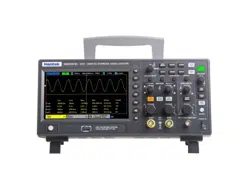Loading ...
Loading ...
Loading ...

User Manual
28 / 68
1. Press the [Trig Menu] button on the front panel to enter the Trigger system function menu.
2. Press the Type softkey, then use the Multifunctional Knob to select Pattern and push down the knob to confirm.
3. Press the Logic softkey, turn the Multifunctional Knob to select a logical "AND" or “Or” combination of channels and
push down the knob to confirm.
4. Press Pattern to set the pattern of the current signal source, turn the Multifunctional Knob to select a pattern. At this point,
the corresponding pattern is displayed on the menu. The patterns of channels CH1-CH2 are presented from left to right. You
can set the pattern of a signal source when the souce is open. Press Pattern softkey to set pattern for other sources.
1: Set the pattern of the channel selected to "H", namely the voltage level is higher than the trigger level of the channel.
0: Set the pattern of the channel selected to "L", namely the voltage level is lower than the trigger level of the channel.
X: Set the pattern of the channel selected to "Don’t Care", namely this channel is not used as a part of the pattern. When all
channels in the pattern are set to "Don’t Care", the oscilloscope will not trigger.
: Set the pattern to the rising edge of the channel selected.
: Set the pattern to the falling edge of the channel selected.
: Set the pattern to the rising or falling edge of the channel selected.
5. Press the Level softkey to set the trigger level. For the analog channels, the trigger level of each channel needs to be set
independently. For example, set the trigger level of CH1. Press Level softkey to select CH1, and then use Trigger level knob
to modify the level. Press Pattern softkey again to set the trigger level for other source.
6. Press the Mode softkey, turn V0 to select the trigger mode (auto, normal), and press V0 to confirm.
Auto: When the oscilloscope meets the trigger condition, it completes a trigger acquisition once; when the trigger condition is
not met, it can run the acquisition waveform freely.
Normal: When the oscilloscope meets the trigger condition, the input waveform is displayed; when the trigger condition is not
met, the original waveform is displayed.
7. Press the Holdoff softkey and turn V0 to set the time that the oscilloscope waits before a trigger to the next trigger, so that
complex waveforms are displayed stably.
2.7.8. Interval Trigger
Trigger when the time difference between the neighboring rising or falling edges meets the time limit condition (<, >, !=, =).
To set interval trigger:
Loading ...
Loading ...
Loading ...
